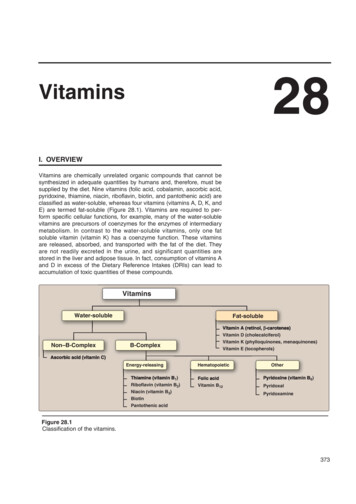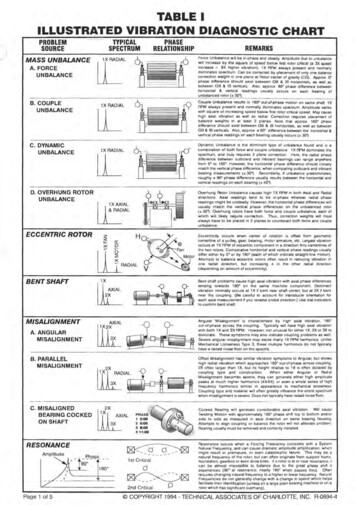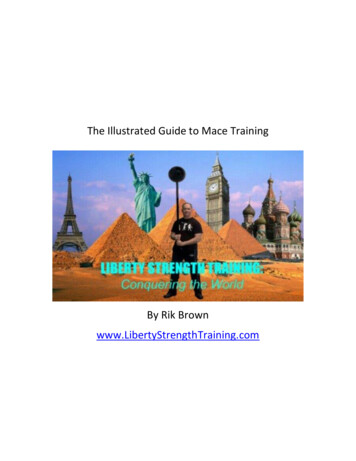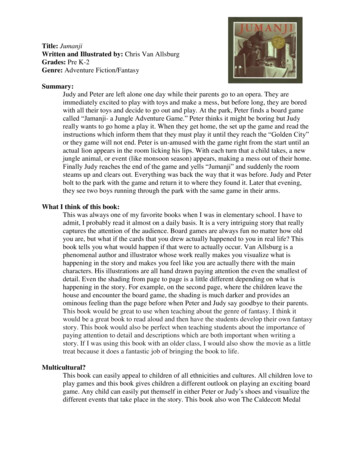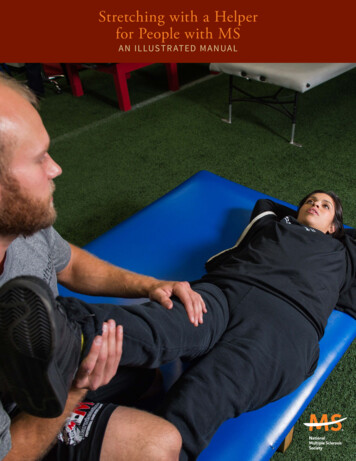
Transcription
Stretching with a Helperfor People with MSA N ILLUS TR ATED M A NUA L
Stretching with a Helperfor People with MSA N ILLUS TR ATED M A NUA LBY: BETH GIBSON, PTBeth Gibson, PT, graduated from the Mayo School of Health Related Sciences in Rochester,Minnesota, and worked with people living with MS for 20 years.Special thanks to Susan Kushner, MS, PT; Cindy Hugos, MS, PT; Cindy Gackle, OTR/L, MSCS; andBrian Hutchinson, PT, MSCS; for their valuable assistance.Drawings by iMageWorx. Some of these drawings originally appeared in Multiple Sclerosis: ASelf-Care Guide to Wellness, published in 1998 by Paralyzed Veterans of America, Inc. They arereproduced here with the kind permission of PVA, Inc. Additional images produced by NicolaFester, 2011. 2019 NATIONAL MS SOCIETY. ALL RIGHTS RESERVED.
ContentsGeneral Introduction. 1Summary of Special Terms. 2Positioning for Managing Spasticity. 4Spasticity Positions. 5Some Precautions, Both Obvious and Not So Obvious. 8Some Added Safety Instructions for the Helper. 9Shoulder Exercises. 10Elbow and Forearm Exercises. 14Hand and Wrist Exercises. 16Trunk and Hip Exercises. 18Ankle and Foot Exercises. 22Sitting Coordination and Balance Exercises. 25
GeneralIntroductionWith decreased flexibility, contractures mayoccur that can be painful and significantlylimit range of motion to a joint.Everyone with MS, regardless of his or herdegree of ability or disability, needs regularphysical activity. Lack of exercise has serioushealth consequences, ranging from jointcontractures, to heart disease to constipation.Just as important, good exercise programsnot only prevent problems, they promote asense of achievement and well-being. Evenif you cannot move parts of your body withoutsome help, you can and should enjoy thebenefits of exercise.StrengtheningThis booklet focuses on showing your helperhow to move and gently stretch musclesand other soft tissues, such as tendons. Forthe purposes of this book, the familiar term“stretching” is used, though most of theseexercises are, technically, range of motionactivities. Exercise can be broken downinto five categories. All of these categories,including relaxation, are important topeople with MS.FlexibilityFlexibility is stretching the muscle andtendon to its full length and moving thejoint through its full range. These activitiesdecrease muscle tightness and prevent lossof full range of motion which may occur withdecreased activity, weakness, or spasticity.Hold stretches for 30–40 seconds, as tolerated.Strengthening is increasing the force or powerof the muscle. Strength can be increasedby lifting a limb up against gravity, liftingweights, or by working against resistancesuch as machines, rubber tubing, oreven water. Your arms may benefit fromstrengthening exercises even if your abilityto move your legs is reduced.Cardiovascular FitnessEndurance is improving heart, lung andoverall muscle function. Aerobic exercisemakes all muscles work harder, buildingendurance and reducing the risk of heartdisease. Improving cardiovascular fitnesshelps to increase the amount of exerciseand activity one can do, thereby helpingto manage weight and blood lipid (i.e.,cholesterol and triglyceride) levels. Whilebrisk walking may be out of the question,swimming, cycling and adaptive sportsmay be possible. You may want to discussyour aerobic options with a knowledgeablephysical therapist.General guidelines for aerobic activity arefor 15–20 minutes a day, 4–5 times a week.If that is not possible, any amount of activityis better than none. If can also be broken upinto several shorter bouts throughout the day.National MS Society 1
Balance and CoordinationBalance and coordination is improvingquality, safety and efficiency of movement.Specific arm, leg and trunk exercises canbe incorporated to improve the qualityof movement and allow for less energyexpenditure to occur. Activities for balanceand coordination can be done on landor in the water. Yoga and Tai Chi areexamples of specific activities for balanceand coordination that are beneficial whendone properly.RelaxationRelaxation is taking action to reduce physicaland mental stress and tension. Relaxationcan simply mean stopping and taking adeep breath, sitting while listening to softmusic or doing yoga. Structured relaxationtechniques can reduce fatigue from an exercisesession or help manage a stressful day. TheNational MS Society’s booklet “Taming Stressin MS” contains directions for several kindsof structured relaxation exercises.Summary ofSpecial TermsYour physician or physical therapist may usethe following technical terms to describerange of motion and movement.Range of MotionRange of motion is the extent of movementthat is possible within a joint.Passive Range of MotionPassive range of motion is the extent ofmotion possible in a joint when movedwith assistance (i.e., by a therapist, helper,or a piece of machinery).Active Range of MotionActive range of motion is the extent ofmovement that is possible in a joint whenthe person moves without assistance.Active Assisted Range of MotionThe patient is doing part of the work and isbeing assisted by the helper.2 Stretching with a Helper for People with MS
SpasticityBasic Exercise MovementsSpasticity is tightening or stiffness of themuscle due to increased muscle tone andexaggerated response to muscle stretch.FlexionJoint ContracturesJoin contractures are a limitationin the range of motion that impairs thefunction of a joint.Disuse Muscle AtrophyDisuse muscle atrophy is the decrease in size— and eventually in strength — of musclefibers that have not been contracted for aperiod of time.Flexion is the act of moving a joint so thatyour limb or trunk is bending. Usually themuscle is shortening.ExtensionExtension is the act of moving a joint sothat your limb or trunk is straightening out.Usually the muscle is lengthening.AbductionAbduction is the act of moving a jointso that your limb is moving away fromthe middle of the body.AdductionAdduction is the act of moving a joint sothat your limb is moving toward the body.National MS Society 3
Positioning forManaging SpasticitynWhen exercising, try to keep your headstraight (not tilted to one side).nIf you are using a spasticity-reducingdrug, time exercise to beginapproximately one hour after takingthe medication.nYour antispastic drug dose should bechecked frequently, as spasticity changes.nSudden changes in spasticity may occurin the presence of infections, skin sores,or even tight shoes or clothing.SpasticitySpasticity can be defined as a tightening orstiffness of the muscle due to increased muscletone, and is often made worse when musclesare quickly stretched or moved. It can be oneof the most common and frustrating symptomsof MS and can interfere with normalfunctioning. It can also greatly increasefatigue. However, exercise, when doneproperly, is vital in managing spasticity.The Following Tips May Prove Helpful:nAvoid positions that make your spasticityworse.nDaily stretching of muscles to their fulllength will help to manage the tightnessof spasticity, and allow for optimalmovement.nKeep in mind that moving a spasticmuscle to a new position may result inan increase in spasticity. If this happens,allow a few minutes for the musclesto relax.4 Stretching with a Helper for People with MSPositions Seen with Spasticity& Ways to Decrease SpasticityKeep in mind that you want to refrain fromactive exercises that accentuate a positionassociated with any spasticity you experience.For example, if you have extensor spasticity,refrain from doing the active exercises thatstraighten the hip and knee to the extentthat it sets off the spasticity.It is important to remember that the positionsin this section are designed to decreaseyour spasticity. If they do not, consult yourphysician or physical therapist.
Spasticity PositionsThese are positions that the body tends to move towards when spasticity is dominant.Flexor SpasticityCommon in people with multiple sclerosis.The hips and knees are maintained in a bentposition with hips turned inward.Less frequently, hips and knees are turned outward.Knees are bent in a flexed position and feet tend topoint in a downward direction.Extensor SpasticityThe hips and knees are maintained in astraightened position, and the legs are veryclose together or crossed over, with the feetin a downward position.National MS Society 5
Positions to Manage SpasticityThese positions will help your body reduce spasticity.Lying on Your Stomach (Prone Position)This is an excellent position to try if you havespastic hip and knee flexors. Remember, giveyourself a few minutes to allow your hip musclesto relax in this new position. If able, let your toesand feet hang over the edge of a bed to allowa neutral ankle position. As your hips relax, sowill your calf muscles.Lying Face Up or In 3/4 PositionIf your knees tend to roll inward, try placinga rolled pillow or towel between your knees.Again, allow time for your legs to accommodateand relax in the new position for a few minutes.Pillows under the knees only reinforce the kneeflexion and should be avoided.Lying on Your Side (Side-lying)This is an excellent position if your hips andknees are prone to extensor spasticity. Whilelying on your side, bend the knee of your top legand let the knee of your bottom leg be straight.You can also put a rolled pillow or towel betweenyour legs.6 Stretching with a Helper for People with MS
Correcting Hip Turn OutIf your hips and knees assume a “frog like”position due to spasticity, try lying on yourback. Place the end of a pillow, or a large beachtowel, under your upper thigh (hip to knee).Roll the towel or pillow so that your hips andknees align themselves. Your knees should bepointed toward the ceiling.Correcting Foot Turn DownIf your ankles and feet turn in a downwardposition, you want to try to position your anklesand feet in a neutral position — that is, withyour toes pointed up toward the ceiling. Theeasiest way to achieve this is to place your feetagainst a padded footboard. If your bed doesnot have a footboard, resting ankle splints,bracing or other orthotic measures may beneeded. Talk to your physician or physicaltherapist to determine which is best for you.Correcting Bent ElbowsIf your elbows tend to bend, and your armsremain close to your body, try lying down withyour arms out alongside your body, on pillows,and your hands positioned palms down.National MS Society 7
Some Precautions,Both Obvious &Not So Obvious1. Wear clothing that doesn’t restrictmovement.2. Be sure the room temperature iscomfortably cool. Consider a fan, airconditioner, or open window. If you areespecially heat-sensitive, consider a coolshower or a 10-minute soak in a cool tubbefore exercising. (Start with lukewarmwater, slowly adding cooler wateruntil the water feels like a coolswimming pool.) Or experimentwith cooling headbands, vests, orneck wraps.3. Don’t let your helper force anymovement that causes pain or increasesspasticity. Some feeling of stretch isfine; pain, numbness or tingling are not.If pain occurs, stop. Check with yourhealth care professional before tryingthat move again. If discomfort occurs,cut back to a motion that’s easier.8 Stretching with a Helper for People with MS4. Progress as tolerated while alwayslistening to your body. And remember,your body will vary from day to day. Theidea is to increase the range of painfree motion. Therefore, it’s importantto distinguish between pain and thefeeling of stretch. Stretch is okay;pain is not.5. Remember to breathe evenly and relaxyour face throughout each movement.There’s a tendency to grimace orhold the breath during an unusualmovement.6. Avoid overexertion. Include restperiods, and sip cool water to preventoverheating or dehydration.7. Experiment with different times of theday. Some people find early morningbest; some find it helpful to breakexercise sessions into two parts: onein the morning, and the other in theafternoon or evening.8. If you experience spasticity, incorporatethe tips on page 4 for increased successwith your stretching program.
Some AddedSafety Instructionsfor the Helper1. If the person you are helping is in anelectric or hospital bed, raise the bedto a comfortable level so that you arenot putting strain on your back.2. If the person is in a regular bed, sit orkneel on the bed so that you are notputting strain on your back.3. Don’t try to “fight” a spasm or tightmuscle. This could result in injury toboth of you. Move in slow, easy motionsto allow the tight muscles to relax andspasms to reduce.4. Go slowly. All movements should bedone evenly, allowing the muscles timeto respond to the stretch by relaxing.Moving quickly can increase spasticityor stiffness. Hold each stretch for 30–40seconds at the comfortable far end of rangefor the person you are helping. It may helpto count out loud or use a timer. Thengently return to the starting position.5. Look for range of motion to increaseover time. The idea is to increase therange of pain-free motion. Try to holdeach stretch for 30–40 seconds. Thengently return to the starting position.6. Remember to keep communicationopen and to listen to the person youare helping.National MS Society 9
Shoulder ExercisesThe following shoulder exercises may also be done sitting in a chair, scooter or wheelchairwith back support.Shoulder Flexion — This is Similar to Raising Your Hand in ClassInstructions to HelperStarting position: Person lying on their back,arm at their side, palm down. Place one handunder the shoulder to stabilize it. Position thethumb of that hand on top of the shoulder, tomonitor the joint movement. With other hand,hold the wrist.Step 1: Keep the elbow straight and lift the armuntil the hand points to the ceiling, with palmtoward the center of the body.Step 2: Continue to move the arm back untilit rests on the bed next to the person’s head, oruntil you meet resistance. The arm may be bentat the elbow if the headboard of the bed will notpermit the arm to be carried all the way back.Hold 30–40 seconds.Return to the starting position, rest, then repeat2–3 times.Repeat exercise with the other shoulder.10 Stretching with a Helper for People with MS
Shoulder Abduction — This is Similar to a One-armed Jumping JackInstructions to HelperStarting position: Person lying on their back, armat their side. Place one hand under the shoulder tostabilize it. Position thumb of that hand on top of theshoulder, to monitor the joint movement. With otherhand, hold the wrist.Step 1: Keep the elbow straight and move thearm out, away from the body.Step 2: Rotate the arm so that the person’s palmfaces up.Step 3: Continue moving the arm back until it restson the bed next to the person’s head, or until youmeet resistance. The arm may be bent at the elbowif the headboard of the bed will not permit the armto be carried all the way back.Hold for 30–40 seconds.Return to the starting position, rest, then repeatthe exercise 2–3 times.Repeat exercise with the other shoulder.National MS Society 11
Shoulder ExercisesThe following shoulder exercises may also be done sitting in a chair, scooter or wheelchairwith back support.Shoulder RotationInstructions to HelperStarting position: Person lying on their back.The arm is positioned out to the side even withthe shoulder. Place one hand under the shoulderwith thumb of that hand on top of the shoulder.With other hand, hold the wrist, making surethe elbow rests on the bed and the forearmpoints up.Step 1: With your hand on the wrist, keep theperson’s elbow bent and slowly move the forearmdown, palm down, until it rests on the bed, oryou meet resistance. (Note: The hand may nottouch the bed in one or both directions.)Hold for 30–40 seconds, then return to thestarting position.Step 2: With your hand still on the wrist,slowly move the forearm back, palm up,until it rests on the bed, or you meetresistance.Hold for 30–40 seconds.Return to the starting position, rest, then repeatthe exercise 2–3 times.Repeat exercise with the other shoulder.12 Stretching with a Helper for People with MS
CAUTION: SHOULDER EXTENSIONPlease go very gently with this stretch and ask the person you are helping to tell youif she or he feels any discomfort. Stop if this happens.Shoulder ExtensionInstructions to HelperStarting position: Person lies on one side or sitsin a chair.Step 1: Stabilize the shoulder with one hand andcup the arm just above the elbow with the other.Step 2: Move the arm straight back, allowingthe forearm to dangle.Hold for 30–40 seconds.Return to the starting position, rest, then repeatthe exercise 2–3 times.Repeat exercise with other arm.National MS Society 13
Elbow & Forearm ExercisesThe following elbow and forearm exercises may also be done sitting in a chair, scooter orwheelchair with back support.Elbow Flexion and ExtensionInstructions to HelperStarting position: Person lies on their back,arms at their sides, palms turned toward body.Hold the wrist and hand with one hand andstabilize the elbow with your other hand.Step 1: Gently raise hand as close to the shoulder aspossible, keeping elbow and upper arm on the bed.Hold for 30–40 seconds.Return to the starting position, rest, then repeatthe exercise 2–3 times.Repeat exercise with other arm.14 Stretching with a Helper for People with MS
Forearm RotationInstructions to HelperStarting position: Person lies on their back,arms at their sides, palms turned toward body.Hold the wrist and hand with one hand andstabilize the elbow with your other hand.Step 1: Gently raise the hand as close to theshoulder as possible, keeping elbow and upperarm on the bed. Slowly rotate the hand andforearm in a clockwise direction. Repeat rotationin a counter clockwise direction.Hold for 30–40 seconds.Return to the starting position, rest, then repeatthe exercise 2–3 times.Repeat exercise with other arm.National MS Society 15
Hand & Wrist ExercisesThe following hand and wrist exercises may also be done sitting in a chair, scooter orwheelchair with back support.Wrist Range of MotionInstructions to HelperStarting position: Person lying on their back,arm out from their shoulder, elbow bent, handpointing toward the ceiling. Hold person’s handwith one hand and hold their wrist with yourother hand.Step 1: Bend wrist forward as far as possiblewithout pain.Step 2: Bend wrist back as far as possiblewithout pain.Step 3: Return to starting position, rest, thenrepeat the exercise 2–3 times.Step 4: Bend wrist sideways , in the direction ofthe little finger, as far as possible without pain.Step 5: Bend wrist sideways, in the direction ofthe thumb, as far as possible without pain.Return to starting position, rest, then repeatthe exercise 2–3 times.Repeat exercis
BY: BETH GIBSON, PT Beth Gibson, PT, graduated from the Mayo School of Health Related Sciences in Rochester, Minnesota, and worked with people living with MS for 20 years. Special thanks to Susan Kushner, MS, PT; Cindy Hugos, MS, PT; Cindy Gackle, OTR/L, MSCS; and Brian Hutchinson, PT, MS

